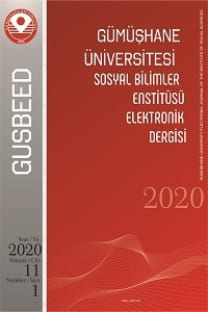Çerçeveleme Etkisi: Asya Hastaliği Probleminin Gerçeğe Dönüşü Covid 19 Problemi
Karar verme, Çerçevelene Etkisi, Asya Hastalığı, Covid 19
Framing Effect: Asian Disease Problem Turns to Reality: COVID 19 Problem
Decision making, Framing effect, Asian disease, Covid 19,
___
Anderson, J. R. (1993). Problem solving and learning. American Psychologist. https://doi.org/10.1037/0003-066X.48.1.35Arkes, H. R. (1991). Costs and benefits of judgment errors: Implications for debiasing. Psychological Bulletin. https://doi.org/10.1037/0033-2909.110.3.486
Druckman, J. N., & McDermott, R. (2008). Emotion and the framing of risky choice. Political Behavior. https://doi.org/10.1007/s11109-008-9056-y
JASP Team. (2018). JASP (Version 0.8.6.0). [Computer Software].
Kahneman, D., & Tversky, A. (1979). Prospect Theory: An Analysis of Decision under Risk Daniel Kahneman; Amos Tversky. Econometrica.
Kim, S., Goldstein, D., Hasher, L., & Zacks, R. T. (2005). Framing effects in younger and older adults. Journals of Gerontology - Series B Psychological Sciences and Social Sciences. https://doi.org/10.1093/geronb/60.4.P215
Lauriola, M., Russo, P. M., Lucidi, F., Violani, C., & Levin, I. P. (2005). The role of personality in positively and negatively framed risky health decisions. Personality and Individual Differences. https://doi.org/10.1016/j.paid.2004.03.020
Levin, I. P., Gaeth, G. J., Schreiber, J., & Lauriola, M. (2002). A new look at framing effects: Distribution of effect sizes, individual differences, and independence of types of effects. Organizational Behavior and Human Decision Processes. https://doi.org/10.1006/obhd.2001.2983
Levin, I. P., Schneider, S. L., & Gaeth, G. J. (1998). All Frames Are Not Created Equal: A Typology and Critical Analysis of Framing Effects. Organizational Behavior and Human Decision Processes. https://doi.org/10.1006/obhd.1998.2804
Mikels, J. A., & Reed, A. E. (2009). Monetary losses do not loom large in later life: Age differences in the framing effect. Journals of Gerontology - Series B Psychological Sciences and Social Sciences. https://doi.org/10.1093/geronb/gbp043
Reyna, V. F., & Farley, F. (2006). Risk and rationality in adolescent decision making: Implications for theory, practice, and public policy. Psychological Science in the Public Interest, Supplement. https://doi.org/10.1111/j.1529-1006.2006.00026.x
Thomas, A. K., & Millar, P. R. (2012). Reducing the framing effect in older and younger adults by encouraging analytic processing. Journals of Gerontology - Series B Psychological Sciences and Social Sciences. https://doi.org/10.1093/geronb/gbr076
Tversky, A., & Kahneman, D. (1981). The framing of decisions and the psychology of choice. Science, 211(4481), 453–458. https://doi.org/10.1126/science.7455683
- ISSN: 1309-7423
- Yayın Aralığı: Yılda 3 Sayı
- Yayıncı: Gümüşhane Üniversitesi
Bulanık Choquet İntegral Yöntemini Kullanarak Bir Covid-19 Sahra Hastanesi İçin Yer Seçimi
Muhammet Enes AKPINAR, Mehmet Ali ILGIN
Vergi Affına Muhasebe Meslek Mensuplarının Bakış Açısı: Çorum İli Uygulaması
Ela HİÇYORULMAZ, Habib AKDOĞAN
Bingöl Havzası ve Çevresinde Aktif Tektonizmanın Jeomorfoloji Üzerine Etkileri
Kemal KIRANŞAN, Kenan AKBAYRAM, Vedat AVCİ
Sığınmacıların Yükseköğretim Hizmetlerine Erişimi: Mardin Artuklu Üniversitesi Örneği
